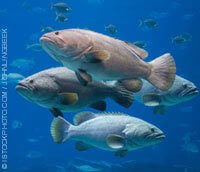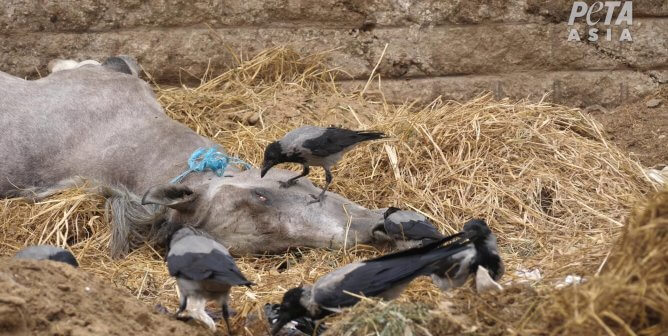Fishing
Billions of fish die every year in nets and on hooks. Humans kill most fish for consumption, torture many just for “sport,” and maim or kill other unintended victims simply because they were in the wrong place at the wrong time. The fact that “fish” is both a noun representing conscious, feeling beings and a verb describing how humans kill them ought to catch our attention.
Fish Feel Pain
Fish begin to suffocate when humans yank them out of the water. Their gills often collapse, and their swim bladders can rupture because of the sudden change in pressure. Numerous scientific reports from around the world confirm that fish feel pain. Researchers from the University of Edinburgh and University of Glasgow studied the pain receptors in fish and found that they were strikingly similar to those of mammals; the researchers concluded that “fish do have the capacity for pain perception and suffering.”
‘Sport’ Fishing
More than 52 million Americans killed fish for “sport” in 2021, spending billions of dollars on their speciesist “hobby.” The number of “sport fishers” has continued to rise since the global COVID-19 pandemic began in 2020, and they’re having a devastating impact.
According to a Florida State University study, sport fishers are responsible for killing almost 25 percent of overfished saltwater species—and the countless untargeted fish and marine mammals humans hook. Anglers have so intensively killed fish in many trout streams that they’re now required to release all fish caught there—the fish in these streams may spend their entire lives having humans repeatedly traumatize and injure them.
What’s Wrong With Catch-and-Release Fishing?
Fish caught and released by humans can suffer from loss of their protective scale coating, making them susceptible to disease, a dangerous build-up of lactic acid in their muscles, oxygen depletion, and damage to their delicate fins and mouths. According to one fishery expert, catch-and-release victims “could be vulnerable to predators, unable to swim away, or if nesting, not capable of fending off nest raiders. Some guarding males could in fact abandon the nest.” Researchers at the Oklahoma Department of Wildlife Conservation found that as many as 43 percent of fish released after anglers caught them died within six days.
Other Victims
In the 2021 documentary Seaspiracy, Capt. Peter Hammarstedt of Sea Shepherd points out that “[o]ver 300,000 whales and dolphins are killed every single year as ‘bycatch’ of industrial fishing.”
Every year, humans kill hundreds of thousands of “nontarget” animals—including sharks, sea turtles, octopuses, rays, seals, manatees, and birds—who are caught or become entangled in fishing nets, like those intended to catch tuna or shrimp. The fishing industry simply discards these animals and leaves them to die. “[U]p to 40% of all marine life caught gets thrown right back overboard if [they’re] ‘bycatch,’ and most of them die before they even hit the water,” says Seaspiracy director Ali Tabrizi.
The documentary presents two other staggering statistics: Humans kill over 11,400 sharks as “bycatch” every hour, and for at least the last 30 years, humans have killed up to 10,000 dolphins as “bycatch” annually off the Atlantic coast of France alone—that’s more than 10 times the estimated 740 dolphins the hunt in Taiji, Japan, reportedly killed in 2020. “Dolphin-safe” labels don’t mean anything.
Seaspiracy also highlights that seabird populations have declined by 70% since the 1950s. According to the National Oceanic and Atmospheric Administration, “[M]ore than one million birds … die each year due to ingestion of, and entanglement in marine debris.” The Florida Fish and Wildlife Conservation Commission reports that discarded fishing line is the number one killer of adult brown pelicans, although one Audubon biologist says that “[p]retty much every type of water or shore bird can get caught up in fishing line …. We find dead cormorants, anhingas, herons, egrets, roseate spoonbills … you name it.”
Eating Fish Is Hazardous to Your Health
Like other animals’ flesh, the flesh of sea animals contains high amounts of fat and cholesterol. “Seafood” is one of the most common causes of food poisoning in the U.S., and almost 7 million Americans are believed to be allergic to it.
Fish flesh (including shellfish) can accumulate extremely high levels of carcinogenic chemical residues, such as polychlorinated biphenyls (PCBs). The flesh of farmed salmon has seven times more PCBs than the flesh of wild-caught salmon.
According to The New England Journal of Medicine, fish “are the main if not the only source of methyl mercury,” a substance that has been linked to cardiovascular disease, fetal brain damage, blindness, deafness, and problems with motor skills, language, and attention span. The Environmental Protection Agency and the FDA warn women of child-bearing age and children to refrain from eating fish such as shark, swordfish, and king mackerel and to consume fewer than 12 ounces a week of other fish flesh because of mercury levels. Of course, the best way to avoid the dangers of mercury is to not eat fish at all.
What You Can Do
- To combat fishing in your area, post and hand out “Take a Closer Look at Fish” leaflets on your land if you have a pond or a lake, join or form an anti-fishing organization, and protest fishing tournaments. Encourage your legislators to enact or enforce wildlife-protection laws.
- Before you support a “wildlife” or “conservation” group, ask about its position on fishing. Groups such as the National Wildlife Federation, the National Audubon Society, the Sierra Club, the Izaak Walton League, the Wilderness Society, the World Wildlife Fund, and many others either support or do not oppose sport fishing.









